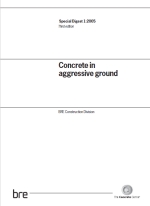Concrete in aggressive ground (SD 1)
BRE (Building Research Establishment) is an independent, research-based consultancy, testing and training organisation, operating in the built environment and associated industries.
On 12 June 2005, BRE published, Concrete in aggressive ground (SD 1), written by the BRE Construction Division.
Chemical agents found in the ground can destroy concrete. In the UK, these agents are most commonly sulfates and acids that occur naturally in soil and groundwater, and can cause the expansion and softening of concrete. Other substances, most resulting from human activity, can be aggressive but present less of a problem as they only rarely come into contact with concrete.
The 2005 edition of BRE Special Digest 1 (SD1:2005) simplifies, updates and consolidates Parts 1 to 4 of the previous edition published in 2003. It was revised to reflect new thinking and changes to the British Standards, including:
- A new ranking of cements in relation to sulfate resistance.
- Removal of the aggregate carbonate range.
- Revision of sulfate class limits.
- Simpler requirements for additional protective measures.
It provides guidance on the specification of concrete for installation in natural ground and brownfield sites. The procedures for ground assessment and concrete specification cover the common occurrence of sulfates, sulfides and acids as well as the more rarely occurring aggressive carbon dioxide found in some ground and surface waters. It is intended to provide practical guidance for ground specialists as well as specification advise for concrete designers, specifiers and producers.
It is presented in 6 parts:
- Part A: Introduces the chemical attack of concrete in the ground.
- Part B: Describes modes of chemical attack and discusses the principal types.
- Part C: Deals with the assessment of the chemical aggressiveness of the ground.
- Part D: Gives recommendations for the specification of concrete for general cast-in-situ use.
- Part E: Gives recommendations for specifying surface carbonated precast concrete for general use.
- Part F: Includes design guides for the specification of precast concrete products.
[edit] Find out more
[edit] Related articles on Designing Buildings Wiki.
- Alkali-activated binder.
- Alkali-aggregate reaction (AAR).
- Architectural concrete.
- BRE articles on Designing Buildings Wiki.
- Brownfield land.
- Building Research Establishment.
- Cellular concrete.
- Concrete.
- Concrete-steel composite structures.
- Concrete repair mortars.
- Concrete superplasticizer.
- Concreting plant.
- Contaminated land.
- Efflorescence.
- Formwork.
- Ground investigation.
- Hempcrete.
- Precast concrete.
- Prestressed concrete.
- Reinforced concrete.
- Self-compacting concrete.
- Testing concrete.
- The properties of concrete.
Featured articles and news
The UK’s largest air pollution campaign.
Future Homes Standard, now includes solar, but what else?
Will the new standard, due to in the Autumn, go far enough in terms of performance ?
BSRIA Briefing: Cleaner Air, Better tomorrow
A look back at issues relating to inside and outside air quality, discussed during the BSRIA briefing in 2023.
Restoring Abbotsford's hothouse
Bringing the writer Walter Scott's garden to life.
Reflections on the spending review with CIAT.
Retired firefighter cycles world to raise Grenfell funds
Leaving on 14 June 2025 Stephen will raise money for youth and schools through the Grenfell Foundation.
Key points for construction at a glance with industry reactions.
Functionality, visibility and sustainability
The simpler approach to specification.
Architects, architecture, buildings, and inspiration in film
The close ties between makers and the movies, with our long list of suggested viewing.
SELECT three-point plan for action issued to MSPs
Call for Scottish regulation, green skills and recognition of electrotechnical industry as part of a manifesto for Scottish Parliamentary elections.
UCEM becomes the University of the Built Environment
Major milestone in its 106-year history, follows recent merger with London School of Architecture (LSE).
Professional practical experience for Architects in training
The long process to transform the nature of education and professional practical experience in the Architecture profession following recent reports.
A people-first approach to retrofit
Moving away from the destructive paradigm of fabric-first.
International Electrician Day, 10 June 2025
Celebrating the role of electrical engineers from André-Marie Amperè, today and for the future.
New guide for clients launched at Houses of Parliament
'There has never been a more important time for clients to step up and ...ask the right questions'
The impact of recycled slate tiles
Innovation across the decades.
EPC changes for existing buildings
Changes and their context as the new RdSAP methodology comes into use from 15 June.

























